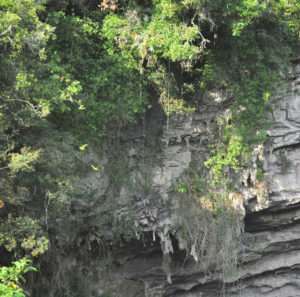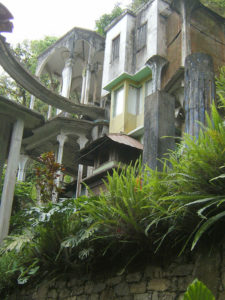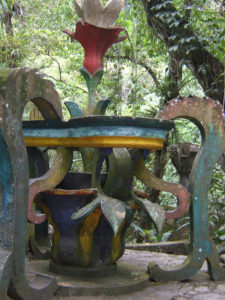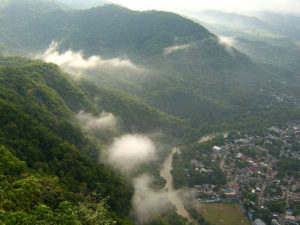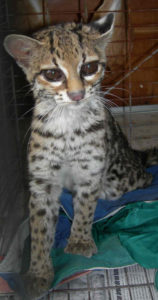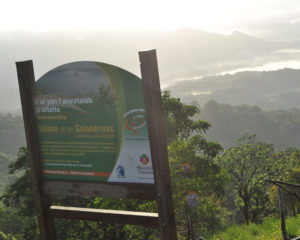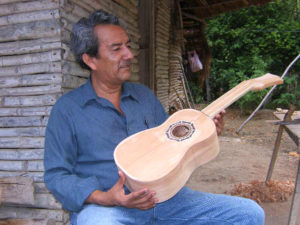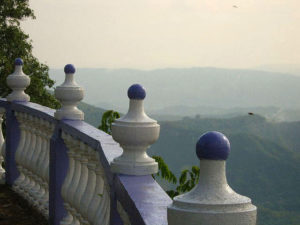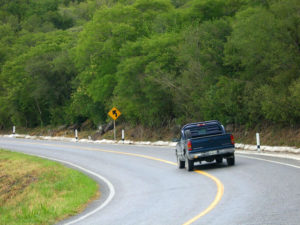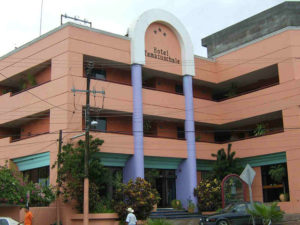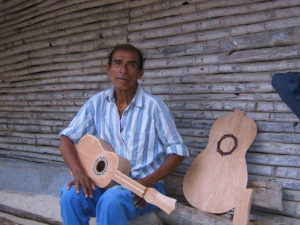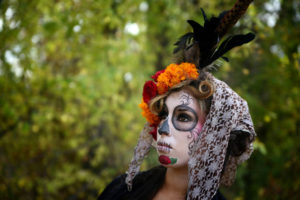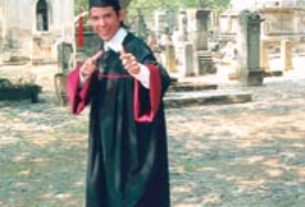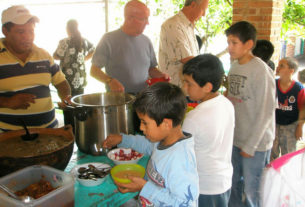Have you ever found a place in Mexico that mirrors your own life? For me, it’s Tamazunchale, San Luis Potosí.
“Every bend of the road reveals a more stunning mountain panorama,” gushed Nicki, a first-time visitor to Mexico.
“Yeah. And there are lots of bends to this road,” I muttered, trying to keep one eye on the temperature gauge, another on the road and another searching for likely spots to pull over so the radiator could cool down every fifteen minutes.
It’s all a matter of perspective. A good Mexico trip will adjust your perspective.
Tamazunchale (pronounced Tam-ah-zun-CHAH-lee, Huastecan for “Place Where The Woman Governor Lives”), is tucked away at the southern end of San Luis Potosí state (15 miles from the northern border of Hidalgo state). It’s not a destination on most people’s most-visited list. It’s not even on most people’s list. At 445 feet above sea level, it’s surrounded by the Sierra Madre Oriental, with peaks up to 3,412 feet that are often shrouded in clouds.
I’ve been drawn here four times. Each time, it’s taught me something new and touched my heart. My heart has beat with the pulse of Mexico since I was seven years old. I now have more than seven times seven years and Mexico still has room enough for me in her heart.
Many people bemoan that they can’t find “authentic” Mexico anymore. Tamazunchale qualifies, with a slow-paced lifestyle, native peoples (Nahua Indians) who live in mountain villages and natural beauty that hasn’t been overwhelmed by Birkenstock-shod ecotourism tour groups.
Your first impression, as you cross the bridge over the Rio Moctezuma, is not inspiring. Seek and ye shall find its charms. They include: more than 20 varieties of orchids, some right by the highway, 200-plus species of birds, huge butterflies, tree squirrels, wild boar, and wolf; camping in Nahua villages, real market days for locals, not tourists, and a generosity of sprit among both Mexican and Nahuatl locals unrivaled in Mexico.
Like me, Tamazunchale used to be more well-known.
From 1936 until 1957, tourists drove down the old Pan American Highway (Highway 85) to Mexico City. Most stopped at Tamazunchale. They had to. The road south of Ciudad Valles imitates a snake wrapping around the mountains. This 62 mile trip can take anywhere from two to four hours. Ninety miles farther south towards Pachuca, the serpentine asphalt climbs to 7,900 feet with a six percent grade.
Nicki described it as taking the White Mountains of New Hampshire, the Green Mountains of Vermont, throwing them into a blender, then adding a dash of the south of Florida. You have winding roads, hills and valleys, with orange trees and palms in the foreground and mountains behind. Down the mountains are fields of sugar cane, agave (from which pulque is made), bananas, palms, and mangoes. Hidden away are small coffee plantations. Some of the drop-offs have only the good wishes of the gods to stop you from joining them. Volkswagen-eating topes, which have been tamed in other parts of Mexico still flourish in their wild state in the towns you drive through. Passing on dangerous curves is the norm. Fortunately, most trucks use the new highway. Around each bend is another view. The road condition was fine — no potholes and animals are now either tethered or behind fences. Anyone who thinks Mexico is two beaches with a desert in between needs to drive 85. The closer you get to Tamazunchale, the more tropical the vegetation becomes. Fog often covers it in late afternoon and early morning.
My first visit was in 1973. Recently divorced and without direction, three of us camped in the forests. We were hippies, yet we were welcomed. Our old car broke down, so I caught a ride with some natives with a truck. Though I spoke little Spanish and no Nahuatl, they divined that I needed to go into town to a refaccionaria (auto parts shop). It still exists, but there is no plaque memorializing my visit. They took me to their village where I learned the linguistic magic of homemade pulque. Around midnight, jabbering what might have been Nahuatl, they returned me to my own tribe. We spent several days in the mountains and were taken into the homes and hearts of everyone.
In 1994, I returned, at the zenith of my egotistical trip as author of the Sanborn’s Travelog, contributor to Mexico guidebooks and the subject of profiles by the Wall Street Journal, New York Times, Texas Monthly and other publications with too much ink and too little editorial control. I was hot stuff, or thought I was. Like Tamazunchale of the ’40s, my highway of fame was bypassed. Fame, as they say, is fleeting.
That’s when I met Rudy and Hildeberto Torres and his wife Emelia, owners of the Hotel Tamazunchale. They hoped that I, the “famous” writer, would encourage hordes of tourists to visit. I was interviewed for the local newspaper. One of the greatest regrets of my life was that my eloquence did little to make Tamazunchale a tourist destination. Maybe I wasn’t so famous after all. Then again, maybe (like most things) it wasn’t all about me. My old friend, Allen Myerson, an editor for the New York Times, went there on my recommendation and wrote a piece for the Times in 1995, which didn’t send droves of tourists either.
Maybe Tamazunchale isn’t for everyone. Thank God for that.
My most recent visit came at the nadir of my career and life. My ego had been leveled. My rented house in Austin had burned to the ground a month before. Fluffy, my elderly dog and I escaped with our lives and nothing else. I was homeless, penniless and, once again, directionless. Mexico has always been there for me. Nicki read my web site and asked me to show her “real” Mexico. We rolled into Tamazunchale in my junker car in late afternoon, spewing steam. Through her eyes, I saw the true wealth of the area. That she appreciated Tamazunchale’s charms induced me to ask her to marry me. (She did by the way).
The region around Tamazunchale is called the Huasteca Potosina. with a humid, mostly mild, climate (50 degrees Fahrenheit for an average winter low with mostly upper 80s in summer). The native peoples are the Nahua. Many still wear their traditional white clothing on festival or market days, and live in the mountains in scattered villages, accessible (with permission) by 4-wheel drive vehicles, burros or, for most of them, by arduous walks. They are kind, reserved and live simply.
You won’t be able to wander into the villages and meet the people without Rudy. He bridges the gap between the modern and the ancient.
Rodolfo Jonguitud Reyes ([email protected]), is the only guide. His mission is to teach his people (he is a Nahua) to balance respect for the ecology and their traditions. Rudy is involved in both cultures. He teaches English, is a volunteer fireman, and works to help others — not for money, but what he gets out of it, which is nothing but the pleasure of helping others. He knows everyone, and they all smile and wave. Being with him is like being escorted by the mayor, but I’m sure he’s more loved than any politician. He can take you on birding and butterfly tours, ecological tours, camping and hiking. He can get you entry to the Nahua villages, Calling him a guide is like calling the Beatles a band. He is un tesoro.
His stove project is worth mentioning.
He found the forgotten designs and parts for an energy-efficient wood stove in a government office years ago. It’s made from cement, straw, cow manure and dirt. The advantages of it are that it consumes one-seventh the amount of wood for daily cooking, saving the forest, and it produces less smoke, saving the lungs of the people. He makes and sells them for $10 to $15 to villagers. He works with 245 Nahua villages in the area. Demand outstrips supply. Although Rudy spends a big chunk of his income on them, he needs donations from outsiders to do much more. That’s where you and tourism come in. He can take you to the Nahua villages, and arrange for you to meet the people or even stay with them. The trip requires a 4-wheel drive vehicle or, if you prefer, a burro. Camping with the villagers will give you a different perspective. Or, you can camp solo on the vista pictured in this article, where you can truly get away from it all and nest with the eagles. It is in places like this that you are likely to find yourself. I did.
Rudy took us in a jeep up to the top of the mountain looking down on Tamazunchale. There is a cross on the top, erected by locals who carried the cement on their backs — their way to pay back for the strength to stop drinking. “We are a short, strong people. We can easily carry 80 kilos on our backs.”
The concrete overlook balustrade is purple and white and there are orchids and avocado trees, agave, maize, cactus, marigolds and other plant life along the way. From this panorama, you can look down on the rivers where they meet, see the whole town and the other mountains in the distance. Often parts of the vista may be covered by clouds.
Drinking to excess is still a favorite pastime of the Nahua. In the ’90s I warned drivers to be careful on Sunday and Monday mornings, as revelers occasionally passed out on the highway. Today, the highway patrol or local cops give them a ride to the trailhead to their homes in the mountains.
Another attraction is to visit Epigmenio Hernández Ramón and Evasto Santos Hernández who make guitars by hand, out of red cedar. Another maker uses pine. It takes two to four days to make one. They sell for about 500 pesos plain, or 700 pesos with intricate inlay design around the center. Most designs are in form of a star, which according to legend brings luck. Yeah, a beautiful handmade guitar for 70 bucks! This is less expensive than many I’ve seen in Paracho, and some guitarists have told me that these sound more mellow.
There is one person left, Ignacio, who makes violins the same way for 500 pesos. It’s a local trade handed down, but the younger generation is not learning it and will be lost when these men die off. There used to be woodcarvers who made animals but the last one, Rudy’s cousin, died a few years ago and the tradition went with him.
The Nahua still have their own Gods — they thank them for everything in the Indian way, and then go to church. They see no conflict in this, figuring it can’t hurt to get all the blessings they can. When they are sick, they are likely to try local herbs first, and a doctor at the IMSS clinic as a last resort.
While there are plenty of wild orchids to see for the adventurous, Rudy’s botanical garden (which doubles as his back yard), has more than 20 varieties. Besides orchids, he has dozens of local plants around the patio.
On the other side of town, we stopped by the river, which is good for swimming (at one spot near the bridge, before the pollution from town enters it). On the other side is Tenquesquicitla, a village where whole families make piñatas. I believe the motto of the village is, “The family that makes piñatas together stays together.” These piñatas are sold all over the Republic. This industry came to be when the government actually sent someone to teach them how to make piñatas out of newspaper and glue made from flour. On the way back, we passed a panteón (cemetery) where, if you want to stay longer, you could be interred for about $40. Just a thought.
Perhaps as a precursor of good things to come, as we returned to town, Rudy spied a couple of reporters for the local paper. Though I was not the “Mexico” Mike of old, the reporters were too young to know the difference. Once again, I got my mug in the paper with promises of bringing tourism to Tamazunchale. Perhaps this time it won’t be an empty promise.
Staying in Tamazunchale
If camping isn’t your bag, rest in comfort at the 3 Star Hotel Tamazunchale (20 de Noviembre #122 PH:483-362-0496 about $50-$65 double, depending on the room), the best in town, with a guarded parking lot. Their web site is www.hoteltamazunchale.com.mx This four-story hotel has a waterfall in the lobby, high-speed Internet in the lobby, character and warmth. Everyone seems genuinely interested in being of service. It is located at the north end of town, just before the bridge over the Rio Moctezuma.
There are other hotels, less expensive, but acceptable. The Tropical (PH: 362-0041) (about $20 double) is across from the bus station. The Mirador (Av. 20 de Noviembre #61. PH: 483-362-0004 , about $25) is down the main street from the bridge. The Hotel Paraiso Huasteco at Mexico 123 (opposite end of town) I have not visited, but is also 3 stars and is supposed to be about $40. The Hotel Virrey (20 de Noviembre #306, PH: 483-362-0308 / 362-0692) is a decent, standard 2 star Mexican downtown hotel and is about $30. Besides the very good restaurant at the Hotel Tamazunchale, there are inexpensive restaurants on the main street that are okay, but hardly worth remembering. None of the hotels take pets willingly.
Getting to Tamazunchale
Until 2011, think twice about coming in from Laredo. The highways and roads in Monterrey were pretty well whacked by Hurricane Alex and while you can get through, the traffic is horrendous.
Laredo, TX Unless you are comfortable driving through a big city, even if all the roads are fixed, going through Monterrey is challenging. Consider driving to McAllen and crossing at Reynosa instead. But if you insist, here are the directions. Take MEX-85 to Monterrey and keep going south. There is a toll road from Laredo-Monterrey, then free four-lane to Linares. Two-lane free after that. When you get to Ciudad Victoria, turn LEFT and take the NEW bypass of the city. There is a nice 9 mile bypass of the city that goes SE towards the airport. Never, ever take the bypass on the West end of town no matter where you are going! (See my web site for my screed on the old bypass). Total miles: 561.
From McAllen, TX these are all free roads. Take MEX-97 to MEX-101 Ciudad Victoria, then MEX-85 to Tamazunchale. There are alternating three-lane four-lane highways to Ciudad Victoria. See the instructions for the bypass of Ciudad Victoria above. Total miles: 405.
You could drive to Tamazunchale in a day from Texas, but youll probably stay in Ciudad Victoria or Ciudad Valles. Do not even think of attempting the winding road between Ciudad Valles and Tamazunchale at night. And do not leave too early in the morning, as it is often fog-bound. A truly enjoyable hotel in Ciudad Valles is the Hotel Valles, the site of my very first trip to Mexico in 1957. They have renovated a few times since, but still have the feel of a Graham Greene faded grandeur hotels. The hotel is surrounded by tropical rain forest and in the morning and evening you will be serenaded by a choir of wild birds.
From Mexico City, just go north to Pachuca on MEX-85. The same caveat as above applies here between Ixmiquilpan and Tamazunchale. Although there is little love lost between me and Ixmi, you really should stay there if it is late. This town has a distinct Otomi population and they have a reputation for being unfriendly to strangers which basically means anyone not from their tribe. Dont feel singled out if some people are rude to you they are just as rude to Nahuatl people and Mexican people from Pachuca and Guadalajara as they are to gringos from Garland, TX.
From Guadalajara or Morelia, take MEX-15 (my favorite, because it is scenic) or MEX-15D (fast, dull toll road) to Atlacomulco and then north to MEX-57 just south of San Juan del Rio. Then there are two choices. The direct route is to go straight on MEX-45 to Portezuelo then north on MEX-85. The more scenic route mirrors the Mission Route and passes through Xilitla. Go up a little bit on MEX-57 to San Juan del Rio, then East on MEX-120.
Nearby Attractions
Near Ciudad Valles are several waterfalls, mainly Micos, Tamasopo and Tamul. A sulpher warm spring is Taninul east of town. No hotel in Ciudad Valles takes pets, though you can sneak one in at the pricey Hotel Valles.
Xilitla, home of Las Pozas, the surrealistic sculpture garden created Sir Edward James is only 45 minutes north. James was called the “craziest of the surrealists.” Much of the original land is being subdivided, so there’s no telling how long the sculptures will be there.
West of Xilitla on Hwy 120 is the Fray Junipero Serra route with missions of Jalpan and Concá. This also connects to Hwy 57 to San Miguel de Allende.
Miscellaneous
If you dont get ahold of Rudy by email, ask for him at the Hotel Tamazunchale or the local municipal offices or the newspaper offices (near the bridge). Nearly everyone in town knows him. To contribute to Rudy’s ecological efforts or stove-building projects, contact Clark Van Duzer, PH: 707-869-0938 (office), 916-967-7033 home.
Most of the month of April is a festival in Tamazunchale. Some traditional native festivals, are November 1: Todos Santos, November 12 Nuestra Señora de Guadalupe, November 25: Festival of Santa Catalina in Axtla between Tancanhuiz and Tamazunchale, and Tanquián 30 miles east on March 18th (San Jose), or Matalpa, June 29 (San Pedro).

